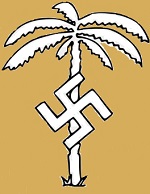Forces of Valor FOV801008B German 88mm Flak 36/37 Anti-Aircraft Gun with FLaK Rohr 18 Gun Barrel and Sd. 202 Towing Vehicle - Deutsches Afrika Korps, El Alamein, North Africa, 1942 [Comes with Seven Crewmen and Rommel] (1:32 Scale)
"[American troops] knew that the greatest single weapon of the war, the atomic bomb excepted, was the German 88 mm flat-trajectory gun, which brought down thousands of bombers and tens of thousands of soldiers. The Allies had nothing as good, despite one of them designating itself the world's greatest industrial power."
- Paul Fussell, 1989
 Originally developed as an anti-aircraft gun, the 8.8cm FLugzeugAbwehrKanone ("Flak") was first employed in the anti-tank gun role in 1936, when the German Condor Legion was testing out its equipment during the Spanish Civil War. Amazingly, German war planners had designed the gun as an AA weapon with a heavy cruciform platform and central fire control operation, not as a multi-purpose anti-tank gun with proper anti-tank sights. Nevertheless, its capability was seen and quietly noted by commanders operating in the field. While the gun was occassionally used in the anti-tank gun role during the Polish and French campaigns, it wasn't until the Afrika Korps joined battle in Cyrenaica with the British Eighth Army that the "88" really showed its prowess as a tank killer. Here the tactical situation was such that it was possible to deploy the guns in their anti-aircraft role in positions that would allow them to be re-trained as anti-tank guns. Moreover their range and penetrating power enabled their crews to dispose of British tanks long before the enemy was close enough to engage the guns with their own two- or six-pounder guns.
Originally developed as an anti-aircraft gun, the 8.8cm FLugzeugAbwehrKanone ("Flak") was first employed in the anti-tank gun role in 1936, when the German Condor Legion was testing out its equipment during the Spanish Civil War. Amazingly, German war planners had designed the gun as an AA weapon with a heavy cruciform platform and central fire control operation, not as a multi-purpose anti-tank gun with proper anti-tank sights. Nevertheless, its capability was seen and quietly noted by commanders operating in the field. While the gun was occassionally used in the anti-tank gun role during the Polish and French campaigns, it wasn't until the Afrika Korps joined battle in Cyrenaica with the British Eighth Army that the "88" really showed its prowess as a tank killer. Here the tactical situation was such that it was possible to deploy the guns in their anti-aircraft role in positions that would allow them to be re-trained as anti-tank guns. Moreover their range and penetrating power enabled their crews to dispose of British tanks long before the enemy was close enough to engage the guns with their own two- or six-pounder guns.
Waltersons' rendition of the flak gun comes with four wheels and a tow hook so that it can be attached to a Sd. Kfz. 7/1 prime mover to form a two-piece set. Both sets of wheels can be removed so that the gun, mounted on a cruciform platform, can be set up in a firing position. Gun elevates and fully traverses. Also comes with seven crewmen and an Erwin Rommel figure.
Now in stock!
Dimensions:
Length: 8-inches
Width: 3-inches
Release Date: May 2019
 Historical Account: "With the Fox" - The Afrika Korps was formed on February 19th, 1941, after the German Armed Forces High Command (OKW) had decided to send an expeditionary force to Libya to support the Italian army, which had been routed by an Allied counteroffensive, Operation Compass. The German expeditionary force, commanded by Erwin Rommel, at first consisted only of the 5.Panzer-Regiment and various other small units. These elements were organized into the 5.Leicht-Division when they arrived in Africa in February.
Historical Account: "With the Fox" - The Afrika Korps was formed on February 19th, 1941, after the German Armed Forces High Command (OKW) had decided to send an expeditionary force to Libya to support the Italian army, which had been routed by an Allied counteroffensive, Operation Compass. The German expeditionary force, commanded by Erwin Rommel, at first consisted only of the 5.Panzer-Regiment and various other small units. These elements were organized into the 5.Leicht-Division when they arrived in Africa in February.
In the spring, the 5.Leicht-Division was joined by the 15.Panzer Division, though it did not arrive until Rommel had already re-taken most of Cyrenaica and gone back over to the defensive. At this time the
Afrika Korps consisted of the two divisions plus various smaller supporting units, and was officially subordinated to the Italian chain of command in Africa (though Rommel had conducted his offensive without any authorization).
On October 1st, 1941, the 5.Leicht-Division was redesignated as the 21.Panzer Division, although it was still attached to the
Afrika Korps. During the summer of 1941, the OKW invested more command structure in Africa by creating a new headquarters called Panzer Gruppe Afrika. On August 15th, Panzer Gruppe Afrika was formally activated with Rommel in charge, and command of the Afrika Korps was turned over to Ludwig Cruewell. The Panzer Gruppe controlled the Afrika Korps plus some additional German units that were sent to Africa, as well as two corps of Italian units. (A German "group" was approximately the equivalent of an army in other militaries, and, in fact, Panzer Gruppe Afrika was re-designated as Panzer Armee Afrika on January 30th, 1942.)





 Great customer service
Great customer service 





![US M4A3(76)W Sherman Medium Tank with VVSS Suspension - Sgt. Daniel "Buttons" Cardell, "Julia", 761st Tank Battalion "Black Panthers", Task Force Rhine, Germany, 1945 [Bonus Ford GAA V-8 Engine] (1:32 Scale)](http://cdn4.volusion.store/qh9e9-jdqv9/v/vspfiles/photos/FOV912132C-1.jpg?v-cache=1739865659)
